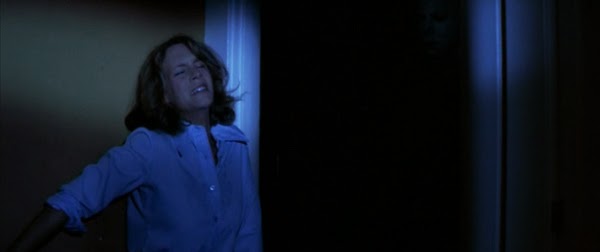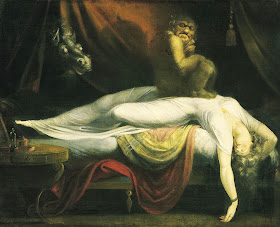"Oh my God... oh my God, he's right behind her!"
(Psycho, 1960)
(Wes Craven's New Nightmare, 1994)
(The Midnight Meat Train, 2008)
The victim is a woman. The villain is a man. The woman has no notion of her doom. The man moves with slow, singular purpose. He is just over her shoulder, looming. The camera - if it cuts at all - quickly returns to the image. And the villain moves closer... and closer.
On one level, this is dramatic irony at its most basic. Threaten a victim with something they don't see. The viewers squirm and shout because they know of the danger. You know, that old Hitchcock line about the bomb under the table that doesn't go off. But on a deeper level, this might be the image of cinematic horror. An image so potent and immediately grabbing and effective that John Carpenter used the technique at least three times in Halloween, with the same victim,and it worked every goddamn time.
(Halloween, 1978)
When she thinks she's killed Michael again.
This scene gets a nod in Scream, when drunk movie dork Randy shouts "Jamie! Jamie! Behind you!" to a television playing Halloween, while, in his world, a killer lurks behind him.
(Scream, 1996)
Of course, Randy's played by Jamie Kennedy, which just adds to the recursion. He screams for Jamie to turn around. We scream for "Jamie" to turn around. In Scream, the victimized hero is a man, and a fair share of horror films take the potency of the "behind you" scare and put a man front and center. A notable example is Jeffrey Combs as Herbert West in Reanimator.
(Reanimator, 1985)
Like the Scream image, this is another shot stuffed with double-meaning, because Lovecraft's original Reanimator story was a spoof on Mary Shelley's Frankenstein, and this exact composition (horizontally flipped) occurs in both Son of Frankenstein and the original classic.
(Son of Frankenstein, 1939)
(Frankenstein, 1931)
Which brings us back to the idea of the victim as a woman. Most importantly, a woman unaware. Some of the women in these movies are nervous or have some knowledge of the killers (New Nightmare, Halloween), but they are completely unaware of the terror right behind them - if they had any real suspicion, the suspense would evaporate. The fact that all of the monsters here are male is a topic that deserves more attention, as is the sexual purity of Laurie Strode, Frankenstein's wife, and even Marion Crane, who basically washes herself free of her former mistakes in that godforsaken shower. The gender politics of horror are a strange beast, as the "purity" of these women is likely an effort to make them less worldly, more innocent, and their impending doom all the more tragic for that innocence.
(The flip-side of this is the unquenchable bloodlust of many post-70s slashers for the sexually experienced woman, a.k.a the slut who has it coming. Again, strange. The Puritan hangups of so many horror movies is a topic for another day.)
Returning to the image, I've mentioned before that James Whale took his cues for his sneak-up moment from the 1922 classic The Cabinet of Dr. Caligari. Word on the street is that Whale screened the film constantly during the making of Frankenstein.
(The Cabinet of Dr. Caligari, 1922)
But I'd wager that Robert Wiene, director of Caligari, borrowed from another image where a woman's sleep seems to summon a monster. There's even a similar posture, with the woman's arm draped over her head.
("The Nightmare," 1781, image courtesy of Wikipedia)
And, of course, Fuseli took inspiration himself, most likely from the classic Medieval artistic subject of "Death and the Maiden," commonly attributed to Hans Baldung Grien. Even if you haven't seen it, you've seen it.
("Death and the Maiden," 1518, image courtesy of Wikipedia)
Honestly, no, I don't think so. Henry Fuseli's infamous "The Nightmare" didn't just influence The Cabinet of Dr. Caligari, it also influenced Murnau's Nosferatu, which climaxes with an image of the vampire crouching beside the "resting" body of a female victim (she's dead, but just roll with me on this one).
(Nosferatu, 1922)
Have that in your head? Good. Now, remember that scene in Scream 2 where Cici (Sarah Michelle Gellar) has one of her own "Behind you!" moments?
(Scream 2, 1997)
Before the killer sneaks up behind her, Cici flips through TV channels.
What movie does she stop on?
Well, I'll be damned. Nosferatu.
Horror likes its innocent women and violent men, no question about it. But the classical image of a woman unaware of her own mortality, and that mortality lurking in the guise of a violent man, has a power, an immediate effect. I wonder if Death and the Maiden might operate on a deeper, more elemental plane of our collective mindscape. On the same plane as Joseph Campbell's Boon or Plato's Cave, where to spend too many words explaining their potency is to miss the fact that their potency lies in their primal simplicity. Death and the Maiden. We don't look at it. We feel it.
If you can think of any more images like these, where a female victim is in the foreground, unaware of an approaching male villain in the background, pass it along!
Previous Entries:
Recurring Image - The Terror Beyond the Pines

















This comment has been removed by the author.
ReplyDeleteThere’s a couple of very old things going on here.
DeleteOne is the leftover of the old Motion Picture Production Code instituted in 1930 that stated that bad guys never win and evil is punished or gets its just deserts. So the couple that is engaged in elicit amorous behavior are among the fits offed in a slasher film. They also show how the monster works (think Star Trek red shirts).
The other is something even older, the belief in the frail woman in danger, which is stock in stories from ancient times to the Victorian forward. I immediately think of the woman (maybe Pearl White) tied to the railroad tracks in silent pictures circa 1915 by the dastardly villain with the frock coat, stovepipe hat, and the long mustache with much twirling and gnashing of teeth ensues as he ties her helpless form to the rails, awaiting the 7:12 express. Dudley Doright to the rescue!
Your choice of imagery is quite good as usual. You might add to your gallery Emmanuel Frémiet’s sculpture of a gorilla carrying off a woman, shades of Poe’s Murders in the Rue Morgue -- https://www.ngv.vic.gov.au/essay/stowed-away-emmanuel-fremiets-gorilla-carrying-off-a-woman-2-2/